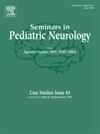Pediatric Neurocysticercosis. Burden of pediatric neurological disorders in resource-limited regions
IF 2.1
4区 医学
Q2 CLINICAL NEUROLOGY
引用次数: 0
Abstract
Neurocysticercosis (NCC) is caused by the parasitic tapeworm Taenia solium, which frequently infects the central nervous system of children and adults. Diagnosis involves a thorough medical history, with an emphasis on the epidemiological conditions of the affected individuals. Understanding the parasite's life cycle and the host's immune response is for a deeper comprehension of their mutual interaction. The most common clinical manifestations include seizures, headaches, increased intracranial pressure, cranial nerve involvement, cognitive dysfunction, radicular and spinal compression symptoms, and ultimately, vision loss, depending on the locations of the lesions. It is essential to know the neuroradiological findings and how they can correlate with the viability and evolutionary stages of the parasite. Since seizures are noted as the most prevalent symptom in the pediatric population, it is crucial to understand how to manage them and the associated symptoms, such as inflammation and other complications. When appropriate, conducting immunological tests and utilizing molecular assays are vital to determine the specificity and sensitivity of these methods in aiding the diagnosis of NCC, especially when neuroimaging results are inconclusive. NCC is classified as active, transitional, or inactive to guide the selection of appropriate treatment options, including antiseizure medications, antiparasitic drugs, anti-inflammatory medications, and surgery when necessary. This document also aims to explore the differences in the natural history of this condition in pediatric populations compared to adults. Prevention and education are the most effective strategies for combating this infection, particularly in underdeveloped areas.
小儿脑囊尾蚴病。资源有限地区儿童神经系统疾病负担
神经囊虫病(NCC)是由寄生绦虫猪带绦虫引起的,它经常感染儿童和成人的中枢神经系统。诊断包括全面的病史,重点是受影响个体的流行病学状况。了解寄生虫的生命周期和宿主的免疫反应是为了更深入地理解它们之间的相互作用。最常见的临床表现包括癫痫发作、头痛、颅内压升高、脑神经受累、认知功能障碍、神经根和脊柱压迫症状,并最终出现视力丧失,这取决于病变的位置。至关重要的是要知道神经放射学的发现,以及它们如何与寄生虫的生存能力和进化阶段相关联。由于癫痫发作是儿科人群中最普遍的症状,因此了解如何控制癫痫发作及其相关症状(如炎症和其他并发症)至关重要。在适当的情况下,进行免疫学测试和利用分子分析对于确定这些方法在帮助诊断NCC时的特异性和敏感性至关重要,特别是在神经影像学结果不确定的情况下。NCC分为活动性、过渡性和非活动性,以指导适当治疗方案的选择,包括抗癫痫药物、抗寄生虫药物、抗炎药物和必要时的手术。本文还旨在探讨与成人相比,儿童人群中这种疾病的自然史差异。预防和教育是防治这种感染的最有效战略,特别是在欠发达地区。
本文章由计算机程序翻译,如有差异,请以英文原文为准。
求助全文
约1分钟内获得全文
求助全文
来源期刊

Seminars in Pediatric Neurology
CLINICAL NEUROLOGY-PEDIATRICS
CiteScore
4.80
自引率
0.00%
发文量
38
审稿时长
84 days
期刊介绍:
Seminars in Pediatric Neurology is a topical journal that focuses on subjects of current importance in the field of pediatric neurology. The journal is devoted to making the status of such topics and the results of new investigations readily available to the practicing physician. Seminars in Pediatric Neurology is of special interest to pediatric neurologists, pediatric neuropathologists, behavioral pediatricians, and neurologists who treat all ages.
 求助内容:
求助内容: 应助结果提醒方式:
应助结果提醒方式:


